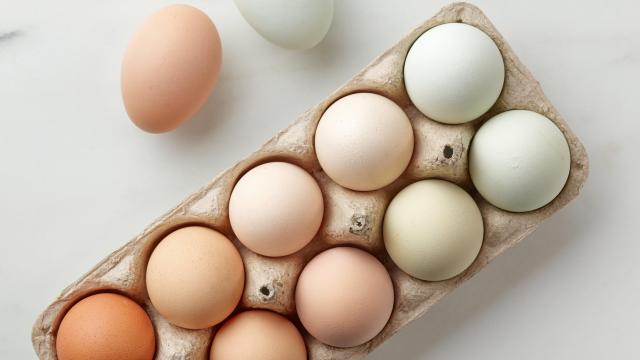If you eat chicken eggs, you probably have a shell colour preference for reasons you can’t explain. Some people only buy brown eggs because they believe they’re “healthier” or more “natural” than white — but is that based on anything more than marketing? What makes an egg white, brown, green, blue, or pink, and does it even really matter?
Shell colour tells you absolutely nothing about what’s inside an egg. When it comes to flavour and nutritional content, all chicken eggs are more or less the same. The characteristics that make some eggs more delicious than others — like extra-large, electric yellow yolks and richer flavour — are mostly a product of whatever the chicken who laid them was eating at the time and the environment they live in. Eggs laid by happy chickens who eat table scraps will always beat the factory-farmed options at the supermarket, but store-bought white eggs are no different from the brown ones next to them on the shelf. (To address another common misconception: White eggs are not just brown eggs that have been bleached.)
If all eggs are the same inside, why do they come in so many different colours? It’s pretty simple: Different breeds lay different coloured eggs. Most commercially-farmed chickens are Leghorns, a breed that lays white eggs; thus, most eggs at the grocery store have white shells. But there are dozens of different chicken breeds out there, some of which deposit pigments on the surface of their eggs before laying them.
It’s not clear why one breed deposits brown shell pigments while another might deposit green, blue, or none at all, but if you’re curious, here’s how it happens: Eggshells form in the shell gland (also called the uterus), which is the second-to-last stage of a chicken’s reproductive system. (The last stage is the vagina, where the laying happens.) This gland is what gives eggs their colour: According to a blog post from the Michigan State extension program, shell formation takes about 20 hours, and pigment deposits happen during the last few hours of that process.
Whether you’re buying them from the store or gathering from your own flock, pretty eggs are just that — pretty. The only time shell colour is worth considering is when researching breeds to raise yourself, and even then, it’s not make-or-break. It’s just one of many characteristics that make a breed unique. Eggs are eggs; once they’re cracked open, you’ll never know the difference.

Leave a Reply
You must be logged in to post a comment.